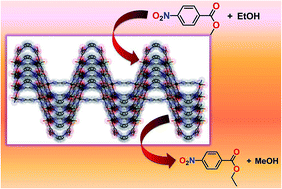ZnII and CdII MOFs based on an amidoisophthalic acid ligand: synthesis, structure and catalytic application in transesterification†
Abstract
Solvothermal reaction of zinc(II) and cadmium(II) salts with 5-propionamidoisophthalic acid (H2L1) and 5-benzamidoisophthalic acid (H2L2) in the presence or absence of an auxiliary ligand gives rise to a series of 1D, 2D and 3D Zn(II) or Cd(II) self-assembled metal–organic frameworks as revealed by X-ray diffraction structural analyses: [Zn(μ-L1-μ-1κOO′:2κO′′)(formamide)2]n (1), [{Zn2(μ-L1-1κO:2κO′)2(4,4′-bipyridine)2(H2O)}·2(DMF)·5(H2O)]n (2), [Cd(μ-L1-μ-1κO2O′:2κO′′2O′′′)(DMF)]n (3), [{Zn(μ-L2-1κO:2κO′)(4,4′-bipyridine)(H2O)}·(H2O)]n (4) and [{Cd(μ-L2-μ-1κO2O′:2κO′′2O′′′)(formamide)(4,4′-bipyridine)}·(formamide)]n (5), which are also characterized by elemental analysis, IR spectroscopy and thermogravimetric analysis. The different architectures found in 1–5 result from the coordination modes of the carboxylate groups, which can assume nonbridging monodentate (in 1, 2 and 4), bridging bidentate (also in 1), bridging chelate (in 3 and 5) and chelate bidentate (also in 5) coordination. While 1 and 5 possess one dimensional double chain type structures, 3 has a 1D cyclic type structure and 2 and 4 have 2D or 3D wave-like structures, respectively. Topological analysis has shown that 1 and 5 have a 3-connected uninodal net with a topological type SP1-periodic net, 2 has a 2,4-connected binodal net, 3 has a 4-connected uninodal net structure and 4 has a more complex 2,2,2,4-connected tetranodal net. Frameworks 1–5 act as heterogeneous catalysts for the transesterification reaction of different carboxylate esters, with 4 showing the highest activity. These heterogeneous catalysts can be recycled without losing activity.



 Please wait while we load your content...
Please wait while we load your content...